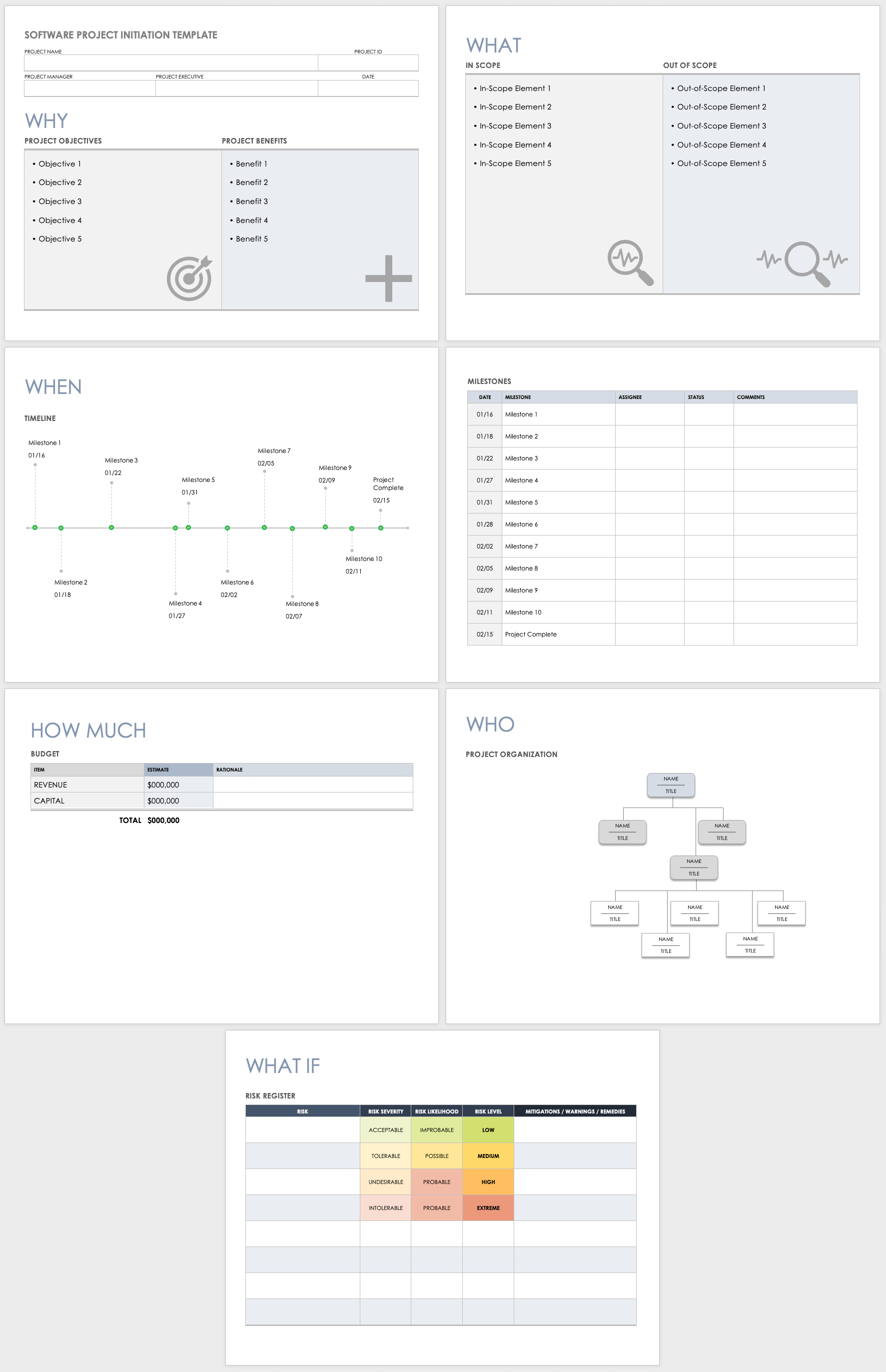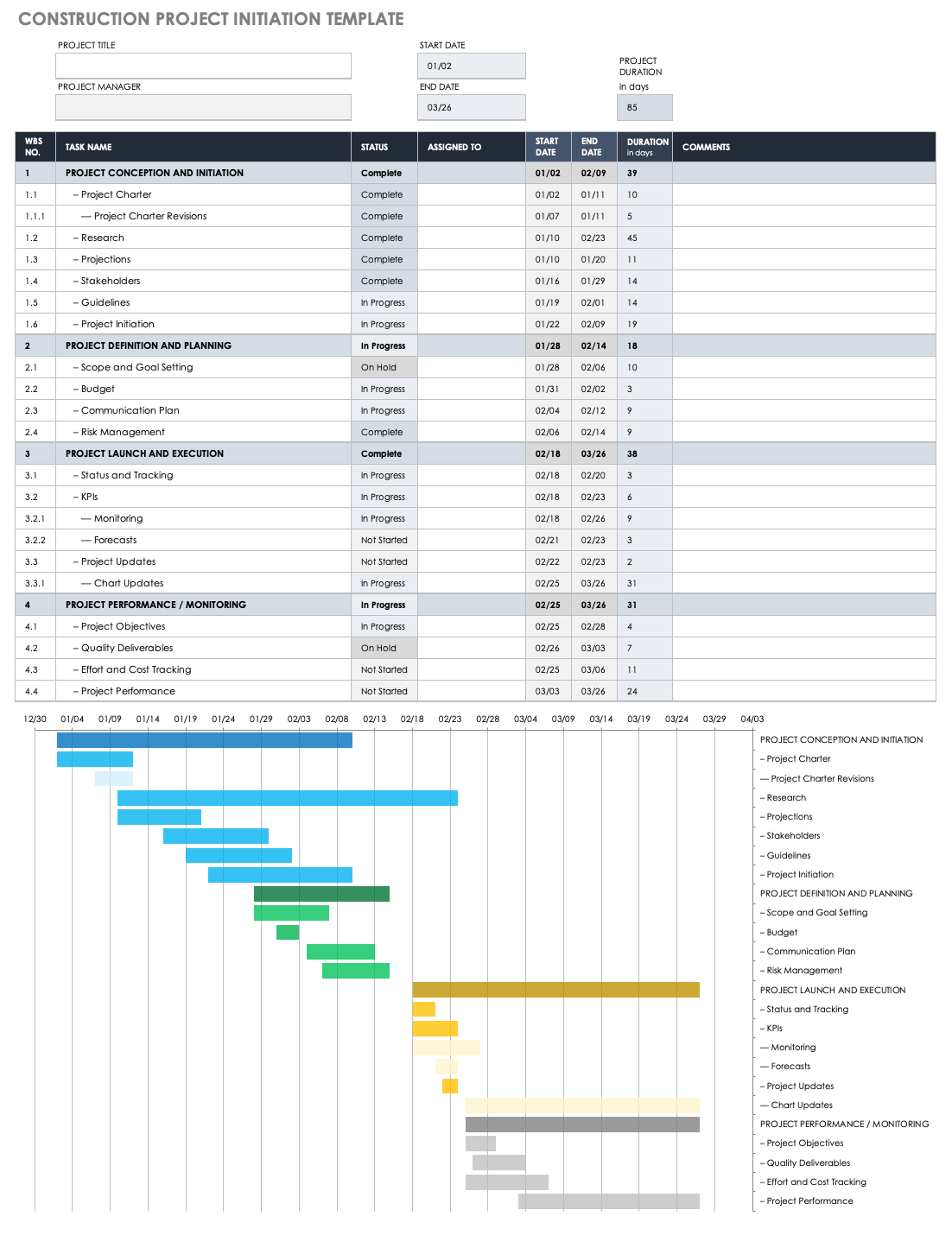Simple Project Initiation Document Template
It’s crucial to have a comprehensive project initiation document (PID) that will serve you from initial brainstorming to project execution, and every step in between. Use this simple template to define your project’s scope, capture team members’ responsibilities, and provide project-centric details, steps, and milestones for success.
Download this template for one-off projects, or save it as part of a larger document for project management, so you can keep all team members and stakeholders looped into the project’s current status — and where it’s headed.
To learn more about this process and to find additional resources, read “Project Initiation.”
Download Simple Project Initiation Document Template
Excel | Word | Google Sheets | Smartsheet
Software Project Initiation Template
This software project initiation template is a perfect fit for project managers (PMs) and digital project managers (DPMs) who want a detailed, all-in-one project initiation and tracking system for all stages of software development. The template offers a visually rich view, which enables team members to keep tabs on details and review the big picture at a glance.
Dashboard-like information includes the project ID, project manager, project executive, date, project objectives, project benefits, scope, timeline, budget, key risks, and approvals. Once you’ve filled out the form, any member of the team can fill in the details of milestones and expectations and keep the software project moving along.
To learn more about this process and to find additional resources, read “Guide to Software Project Management.”
Download Software Project Initiation Template
Agile Project Initiation Template
If your company is dedicated to Agile software development, then your iterative software releases will be much more frequent than in the traditional waterfall approach. This comprehensive project initiation template is designed specifically for Agile projects: It provides everything you need to succeed with the sprint release process, including project name, sponsor, and manager, stakeholders, expected start and end dates, executive summary, key milestones and KPIs, and estimated cost and resources.
To learn more about this process and to find additional resources, read “Everything You Need to Know About Agile Project Management.”
Download Agile Project Initiation Template
Construction Project Initiation Template
In the construction industry, success banks on how well you plan and execute your projects. This construction project initiation template is a perfect solution for all stages of the construction cycle, from project conception and initiation, definition and planning, all the way to project execution and performance monitoring.
You can use this customizable template on a project-by-project initiation, or for multi-project initiation within a master project. This easy-to-use construction project template will help you complete your construction projects on time, within budget, and with all the details and deliverables successfully tracked.
To learn more about this process and to find additional resources, read “A Complete Guide to Construction Management.”
Download Construction Project Initiation Template
What Is a PID in Project Management?
A project initiation document (PID) is crucial to the initiation of any project. Without a PID, your company assumes that everyone knows the actual roles, milestones, expectations, and details of a project.
Historically, the PID was developed as the primary organizing theme for the PRojects IN Controlled Environments (PRINCE2) structured project management method, the primary project management methodology adopted in the majority of Europe (including the UK) and Australia. The PID is the primary tool for the second of seven project management themes: Organization, the role of which, according to PRINCE2’s methodology, is to “define and establish the project’s structure of accountability and responsibilities.”
As a project manager, you need this centralized document in order to collaborate with other project team members. Use this document to define the project’s scope, assign tasks, keep all team members apprised of progress and developments, and ensure that everyone is on the same page.
From initiation to completion, the PID provides accountability for all of the project-critical elements, scope definition, implementation logistics, and, ultimately, the criteria for project success.
If you’ve ever been in a situation where your company discussed a business need or client request, verbally formulated a project plan, and then immediately got started, you’ve probably learned very quickly why this verbal method costs more in the long run, in terms of both time and resources. Without the safeguards of a written plan — which provides all stakeholders with a central document that serves as a charter for the project and as a “contract” for the project’s strategy, logistics, timelines, and all-around expectations of its deliverables — you’ll end up spending considerably more time and resources, not less.
To ensure collaboration and project initiation success, read “A Comprehensive Project Management Guide for Everything RACI.”
What Does a Project Initiation Document Contain?
A PID is a blueprint for a project’s success. Although no two PIDs are exactly alike, they share the same fundamental components to ensure that you’ve clearly defined your project’s scope, assigned team member responsibilities, and considered and recorded all factors in an easily shareable document.
Regardless of the type of PID you use, you will invariably include the same basic sections:
- Project Initiation: Enumerate details, such as required research, names of stakeholders, and project guidelines.
- Project Definition and Planning: Document your project’s scope, goals, budget, and potential risks.
- Project Launch and Execution: Note your project’s status and tracking details, and also reference key performance indicators (KPIs) and project updates.
- Project Performance/Monitoring: State your project’s objectives, list deliverables, track efforts and cost, and evaluate project performance.
How Do You Initiate a Project?
A PID will help you initiate your project by ensuring that you identify the following seven critical steps of the project management initiation process before you begin any work on the project:
- Goals: What is the project trying to achieve?
- Deliverables: What is the project going to provide?
- Scope: What are the project’s boundaries?
- Budget: What are the project’s costs?
- Resources: Who are the project’s team members?
- Risks: What are the project’s potential risks?
- Stakeholders: Who are the stakeholders or clients who can authorize the project?
Although a PID continues on with additional sections related to project launch, as well as project performance, the seven steps above will help you kick off your project to ensure that you and your project team meet success at the finish line.
Any potential project — from conception to delivery of a product or service — requires a centralized system that governs all initiatives, research, projections, stakeholders, responsibilities, and outcomes. A PID is a living document that records the entirety of a project’s details and progress. It also serves as the default reference document that the team can refer to for clarity, any adjustment of details, and documentation of any changes to the project.
Use Project Initiation Templates with Smartsheet for Project Management
From simple task management and project planning to complex resource and portfolio management, Smartsheet helps you improve collaboration and increase work velocity -- empowering you to get more done.
The Smartsheet platform makes it easy to plan, capture, manage, and report on work from anywhere, helping your team be more effective and get more done. Report on key metrics and get real-time visibility into work as it happens with roll-up reports, dashboards, and automated workflows built to keep your team connected and informed.
When teams have clarity into the work getting done, there’s no telling how much more they can accomplish in the same amount of time. Try Smartsheet for free, today.



